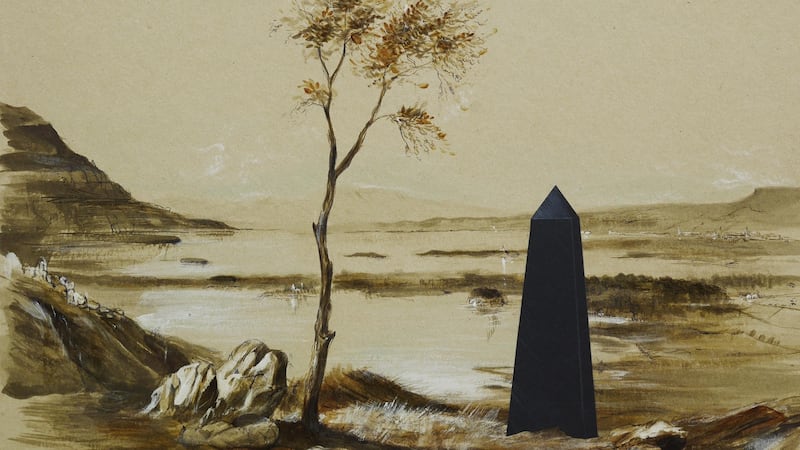Wolf – José María Yagüe Manzanares
★★★★
The work at the heart of Spanish artist José María Yagüe Manzanares's exhibition Wolf has its beginnings back in 2008. That year, a friend of the artist gave him some photographs of the crumpled body of a wolf lying by a roadside. It had been hit by passing motorway traffic in Cuéllar, Segovia. Police officers called to the scene buried the dead wolf. Manzanares's friend knew exactly where it was buried and, some months later, they exhumed the body to recover the animal's skull. Move on a few years and Manzanares was in Ireland, exploring the West coast, making paintings as he travelled.
The paintings were a kind of record of his travels, a visual diary. He depicted familiar and less familiar subjects, in a mode of neutral, deadpan realism and with great technical fluency. It was integral to his project that he carried his work with him as he moved around and display it in accessible locations wherever he could. Somehow it caught the eye of Aoibheann McNamara of Ard Bía in Galway (who, apart from her other interests, is a person of exceptional curatorial flair and experience) and she staged an exhibition of the paintings.
Interred
It may have been during this trip that Manzanares climbed Carrauntoohil and interred the wolf skull close to the summit. It’s hard to pin down an accurate chronology, because several different accounts generate some ambiguity, but he has written that he brought the wolf skull to Ireland at this time. He heard stories of how, in the 18th century, the last of Ireland’s wolves was hunted down close to the mountain’s summit, and he conceived an intervention artwork composed of several strands. One important strand was to place his wolf skull on Carrauntoohil, as a memorial to Ireland’s lost wolves – and as a symbolic reintroduction of the wolf to Ireland.

Wolves exemplify human ambivalence about the natural world. Stories of humans adopted and raised by wolves, as far back as the Roman origin myth of Romulus and Remus and as recently as yesterday, alternate with Little Red Riding Hood and werewolf-type tales, with the wolf as a signifier of pure savagery or, as in the film The Grey, for example, of anthropomorphic malevolence. But then, in that film, as in other fictional narratives, from the wolves' point of view humans – or in the case in point Liam Neeson – are the problem, not the heroes. Despite demonisation, wolves still strike a sympathetic chord, as they do with the classical pianist Hélène Grimaud, to take another example, who co-founded the Wolf Conservation Centre in New York State.
Evolved
Much of the material in Wolf (paintings, drawings, maps, collages, text, video and more) forms part of Manzanares's project, which evolved organically, developing and changing as it went along, largely because that is the way he seems to work. He had long been interested in the relationship between humans and animals in the world, especially wolves, and he grew attached to the mountainous southwest of Ireland. He saw the Wolf project as connecting two territories dear to him, the Castilian plateau and the highlands of Kerry, with a symbolic presence he valued. At first, he aimed to complete it in a more formal way, not just by secretly burying the skull, but also by creating a monument in the form of a black stone slab, sited in the Killarney National Park.
He shows several painted architectonic projections of what he had in mind and they are, in themselves, really impressive works. Other pieces offer variations on the idea of monuments, recalling the Wellington obelisk in the Phoenix Park – probably not by accident, as one strand of the work involved visiting the wolf enclosure at Dublin Zoo, presented in the form of a theoretical proposal to free the wolves there back into the wild.
Time machine
On one of his visits to Ireland Manzanares, like many others, was amazed to discover the Natural History Museum in Dublin. He saw it as a time machine transporting visitors to a 19th-century vision of the natural world, characterised by exploratory zeal, taxonomic ambition and boundless self-confidence, including a comfortable conviction of human superiority. The latter has been systematically undermined since, as humans, however reluctantly, and in no small measure thanks to the efforts of those same 19th-century scientists, learn more about their co-habitants of planet Earth. Manzanares made many paintings of individual "specimens" in the museum, several of which are on view here. Again the works are cool and neutral, but they are also, paradoxically, alive: beautiful portraits of individual animals. These too he exhibited as a group at Art Bía, in part to raise funds for his ongoing Wolf project.

While there is a retrospective cast to much of Manzanares's meticulously representational images, enhanced by such choices as his sepia-like use of green and brown inks, there is no nostalgia in his evocation of 19th-century naturalism. If he is reacting to the contemporary, it is in his quiet insistence on a slow, meditative engagement with the world we live in – that is, the undeniable otherness of the worlds of other species, of nature beyond the hall of mirrors generated by digital communications technologies. Wolf is a fascinating, provocative and enriching exhibition.
- Wolf is at the Oliver Sears Gallery, 29 Molesworth Street, Dublin, until June 22nd. oliversearsgallery.com













